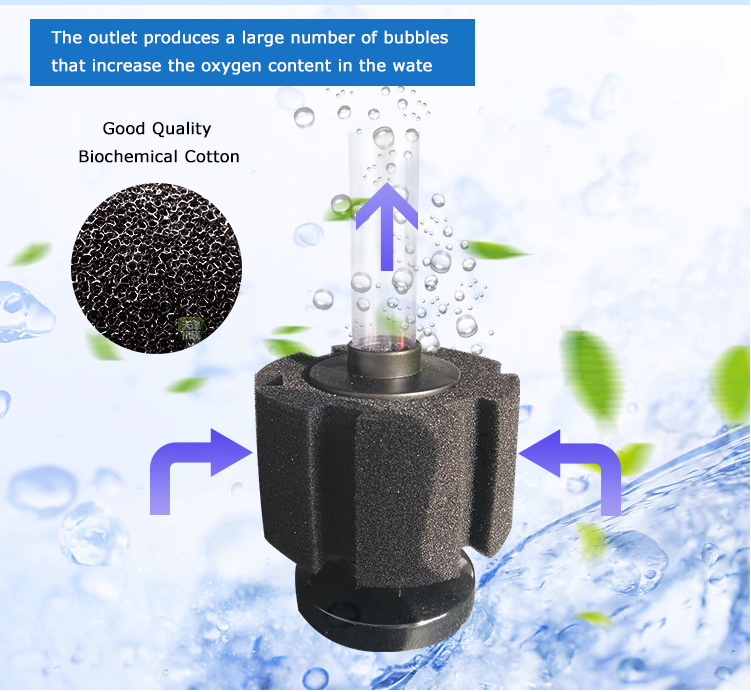A sponge filter is little more than a piece of foam that sits inside your
aquarium and filters your water.
No, seriously – it’s as simple as that!
Particle Removal Rate: High-quality sponge filters can remove particles down to 10–50 microns, capturing over 95% of suspended solids in aquaculture and wastewater systems.
Water Flow Rate: Depending on pore size and density, sponge filters support flow rates from 500 to 2000 liters per hour per
square meter, ensuring effective filtration without clogging.
Lifespan: Durable sponge filters maintain performance for 12 to 36 months under normal operating conditions, significantly reducing replacement frequency and downtime.
Cleaning Frequency: Studies show regular backflushing or cleaning every 3–4 weeks maintains above 90% filtration efficiency.
While sponge filter designs vary from brand to brand, they are typically made up of four different parts:

1. Foam sponge – It wouldn’t be a sponge filter without it.
2. Weighted base – Stops the sponge filter from floating around your tank. The sponge sits on top of this base.
3. Strainer and bulls eye–Slides inside the sponge and allows you to connect airline tubing directly to the filter.
4. Lift tube – Water flows up this and back into your tank.
While it may not look like much, these four parts actually form a very effective filter.
Request Your Custom Sponge Filter Quote
| Factor | Impact | Recommended Specification |
|---|---|---|
| Pore Size (microns) | Smaller pores = finer filtration | 10–50 microns, adjustable by application |
| Material Composition | Affects safety & durability | Non-toxic polyurethane or polyethylene sponges |
| Filter Density (kg/m³) | Balances filtration and flow rate | 15–45 kg/m³ depending on required filtration |
| Service Life (months) | Longer life lowers total cost | Minimum 12 months recommended |
| Installation Ease | Impacts labor and maintenance cost | Modular or customizable shapes preferred |

As for how a sponge filter works, well, it’s very clever…
With a good air pump attached, bubbles rise up the lift tube and out into your tank.
This forces water to be drawn through the foam sponge.
As water passes through the sponge, it catches and traps debris, such as fish poop, uneaten food and decaying plants, filtering it from the water.
Filtered water then passes through the lift tube and back into your tank.
While this filtration method may seem basic, it’s quite effective!
Since sponge filters don’t have a way to force water through them, they are used in conjunction with an air pump, airstone or powerhead. Without one, they are useless.
If you have never heard of a sponge filter before, it may surprise you to learn that they have been around a long time.
While they used to be the preferred way to filter an aquarium, advancements in filter technology have seen the sponge filter become less popular.
But sponge filters are still incredibly useful for your tank!
While sponges continue to make a great cheap primary filter, they are also often used to add an extra layer of protection to your tank.
When used this way, sponge filters are sometimes referred to as pre-filter sponges because they are exactly that – a sponge that sits on your filter tube intake.
Water passes through the sponge before it reaches your filtration system.
Yep, you can use a sponge filter in addition to your primary filter, such as a canister filter, to preventing it from clogging.
Depending on your setup, a sponge filter could be the perfect addition to your aquarium.
Request Your Custom Sponge Filter Quote
| Industry | Application | Performance Benefits | Cost Savings |
|---|---|---|---|
| Aquaculture | Fish tank filtration | >95% suspended solids removal | Up to 30% reduction in water replacement |
| Wastewater | Pre-treatment filtration | 85–90% reduction in solids load | Decreased pump wear by 20% |
| Laboratory | Sample water purification | Consistent micron-level particle filtration | Lower contamination risk, improved data quality |
| Municipal Water | Pre-filtration before treatment | Reduces load on downstream filters by 40% | Extended lifespan of main filtration units |
Manufactured with high-grade polyurethane ensuring chemical stability and resistance to degradation.
Optimized pore structures validated by third-party lab tests achieving >95% filtration efficiency.
Customizable thickness and dimensions to fit diverse water treatment systems.
Proven service life of over 24 months in field tests, reducing maintenance frequency.
Rapid delivery and OEM/ODM service to meet various project demands.